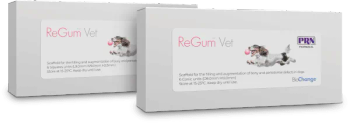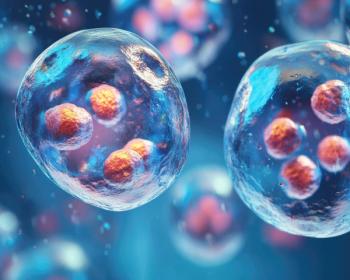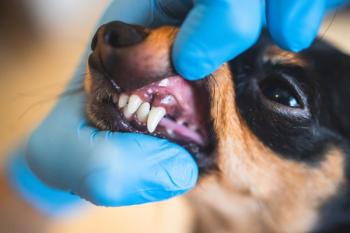
Using bone replacement grafts to repair intrabony defects
Sorting through your choices for repairing these deep-seated defects.
Periodontal disease in dogs and cats presents in many variations. Unfortunately, no one solution exists for all presentations. I reviewed suprabony (above the alveolar crestal bone) pocket care for stage 2 and 3 periodontal pockets in the January 2012 issue. In this article, I address defects below the alveolar crest.
What are intrabony pockets?
An intrabony, or infrabony, pocket occurs when the bottom of the defect is apical (toward the root) of the alveolar crest. This most commonly occurs in the interdental area. Food remnants, leukocytes, plaque-covered calculus, desquamated epithelial cells, serum and fibrin reside in these intrabony defects (Photo 1). Why some dogs and cats develop suprabony defects and others intrabony defects is unknown, but it is probably related to tooth anatomy and position, which contribute to food impaction and plaque accumulation.
Photo 1: The typical appearance of intrabony angular (vertical) bone loss along the distal root of a mandibular premolar. (Photos courtesy of Dr. Jan Bellows)
The intrabony pocket can be further described by the number of remaining osseous walls surrounding the tooth. A direct relationship exists between the prognosis of therapy and the number of intact walls. Three-walled defects typical with palatal pockets render the best prognosis for new attachment, followed by two-walled defects. One-walled or no wall defects carry a poor prognosis.
Your treatment options
A primary goal of periodontal surgery is pocket elimination. When faced with an intrabony defect, your treatment choices include performing an extraction, decreasing the size of the defect through flap exposure followed by apical flap reposition or filling the defect to decrease pocket depth.
Intrabony filling strategies include:
- Removing the intrabony pathological contents with a curette, followed by gingivectomy
- Using a bone replacement graft to fill the cleaned intrabony defect
- Using guided tissue regeneration with or without bone implant material, which involves using a membrane to selectively allow bone and periodontal ligament cells to regenerate the defect
- Placing enamel matrix proteins—use of these proteins and various growth factors is still under human dental investigations with controversial results.
Keep in mind that curettage alone for removal of the pocket contents and gingivectomy to decrease the pocket depth often results in decreased pocket size but in most cases will allow periodontal disease to progress. After curettage, a clot is formed that initially occupies the cleaned intrabony defect. Soon the clot is replaced with granulation tissue and junctional epithelium. This tissue will decrease the pocket size but, unfortunately, there is no real new attachment of the tooth to the alveolus.
Bone replacement grafts
Bone grafts can be successfully used to preserve or restore the alveolar height in deep, narrow, three-walled intrabony pockets, such as palatal defects, that do not extend into the nasal cavity. With stringent postsurgical home care, the bone grafts help restore normal bony architecture, rebuild the periodontal ligament and soft tissue and prevent further periodontal pocket formation.
The grafts increase bone level, increase clinical attachment level and reduce probing pocket depths when compared with open flap débridement procedures alone. Bone replacement grafts should not be attempted on teeth with mobility stage 3 or furcation exposure or in patients that have significant comorbid factors that would affect healing such as poorly controlled diabetes mellitus and end-stage renal disease.
There are many options to select from when choosing bone graft material, including autografts (also called autologous, autoplastic, autogeneic or autogenous grafts), allografts (also called homografts or allologous, allogeneic, allogenous, homologous, homoplastic, homogeneic or homogenous grafts) and alloplasts.
- Autograft: Bone autograft is harvested from a patient's hip or adjacent jaw bone. The advantage is that the tissue is already there. Disadvantages include increased surgical time, increased discomfort and insufficient amount of harvested graft tissue.
- Allograft: Bone allograft is natural bone taken from a donor cadaver of the same species as the intended recipient patient. Human hospital bone and tissue banks are established as the go-to resource for allograft tissues including musculoskeletal (bone, cartilage, tendons, fascia), cardiovascular, ocular and skin grafts. Osteoallograft Periomix (Veterinary Transplant Services) is specifically formulated for veterinary use.
- Alloplast: Bioglass (Consil—Nutramax) is bioactive glass made from calcium salts, phosphate, sodium salts and silicon. The addition of silicon allows for the formation of a silica gel layer over the bioactive glass particles. This layer promotes formation of a hydroxycarbonate-apatite layer onto which osteoblasts are said to proliferate and form bone (osteoconduction).
In a 1999 study, freeze-dried demineralized canine cadaver bone graft was superior to bioactive glass granules in the treatment of intrabony defects in Beagles.1 Bone allograft contains bone morphogenetic proteins (BMPs) that stimulate osteoprogenitor cells in the patient's local periosteum to differentiate into osteoblasts. This process is known as osteoinduction. Inert alloplast synthetic material does not contain proteins helpful to promote bone growth. Synthetic materials commonly used by veterinarians do not contain BMPs. They do provide an inert scaffold for the host bone to slowly grow onto as long as the environment remains favorable. Within weeks to months, the inert alloplast material dissolves whereas the bone allograft integrates with the patient's own bone through the normal bone remodeling process.
Guided tissue regeneration
Guided tissue regeneration describes procedures attempting to regenerate periodontal attachment. Barrier membranes are placed over the cleaned pockets in the hope of excluding an ingrowth of epithelium corium from the root in the belief that it interferes with regeneration of meaningful attachment.
General technique for placing bone grafts
1. If chlorhexidine is used as an irrigant during surgery, rinse it off thoroughly with lactated Ringer's solution since chlorhexidine can devitalize periodontal ligament cells and interfere with attachment.
2. Create an access flap with interdental and sulcular incisions. Plane the root smooth with a curette, and remove excess granulation tissue.
3. Add four to six drops of the patient's blood, sterile water or saline solution to 0.5 ml of the graft material in a dappen dish.
4. Mix the liquid and particulate in the dappen dish with a spatula for 10 seconds to achieve the consistency of firm wet sand, and apply it into the defect area. Alternatively, carry the granules to the defect and mix them with the patient's blood.
5. Suture the access flap without tension.
Postoperative care includes pain control and antimicrobial medication. The patient is fed a soft diet for several days. Gentle brushing can begin one week after surgery. Reexamine the surgical site every two weeks until clinical healing is confirmed, and obtain radiographs of the area in four months.
Technique for palatal periodontal pockets
Palatal pocket therapy is indicated in cases in which > 25 percent attachment loss is present on the palatal aspect of one or both maxillary canine teeth and the periodontal probe does not yet enter the nasal cavity. When deep pockets are diagnosed (Photo 2), pocket therapy should be performed or the tooth should be extracted and the defect closed. If left untreated, the pocket might progress until it penetrates the nasal cavity, creating an oronasal fistula.
Photo 2: A 10-mm intrabony palatal defect measured with a periodontal probe.
1. Make 2- to 4-mm mesial and distal incisions to the bone at 20 degree angles palatally from the affected tooth (Photo 3).
2. Use a Molt or Freer periosteal elevator to gently raise a full-thickness flap.
3. Use a thin curette to clean accessible granulation tissue, calculus and plaque between the root and alveolus.
4. Carry bone-grafting particles into the cleaned defect (Photo 4).
Photo 5: Surgical closure of the palatal periodontal pocket defect site.
Photo 4: Placement of alloplast synthetic graft material (Consil-Nutramax).
Photo 3: Flap exposure of the cleaned palatal periodontal pocket defect.
5. Oppose the flap snugly against the tooth with 4-0 absorbable suture on an atraumatic needle (Photo 5).
Technique for guided tissue regeneration
1. Expose the intrabony defect with a mucogingival flap (Photos 6 and 7).
2. Use a thin curette to clean accessible granulation tissue, calculus and plaque between the root and alveolus. Do not remove clot formation (Photo 8).
Photo 6: A mucogingival defect secondary to orthodontic impingement.
Photo 7: Flap exposure revealing an intrabony defect.
Photo 8: A curette being used to clean the defect.
3. Apply the chosen membrane over the cleaned defect (Photo 9).
4. Follow the manufacturer's directions concerning suturing in the membrane (some do not require suturing).
Photo 9: Placement of guided tissue membrane (Ossiflex Bone Membrane-Veterinary Transplant Services).
Photo 10: Surgical closure of the guided tissue regeneration site.
5. Close the flap over the membrane (Photo 10).
6. Follow the manufacturer's directions to reexamine the patient under anesthesia in three months to monitor resolution.
Dr. Bellows owns ALL PETS DENTAL in Weston, Fla. He is a diplomate of the American Veterinary Dental College and the American Board of Veterinary Practitioners. He can be reached at (954) 349-5800; e-mail:
Reference
1. Hall EE, Meffert RM, Hermann JS, et al. Comparison of bioactive glass to demineralized freeze-dried bone allograft in the treatment of intrabony defects around implants in the canine mandible. J Periodontol 1999;70(5):526-535.
Newsletter
From exam room tips to practice management insights, get trusted veterinary news delivered straight to your inbox—subscribe to dvm360.






